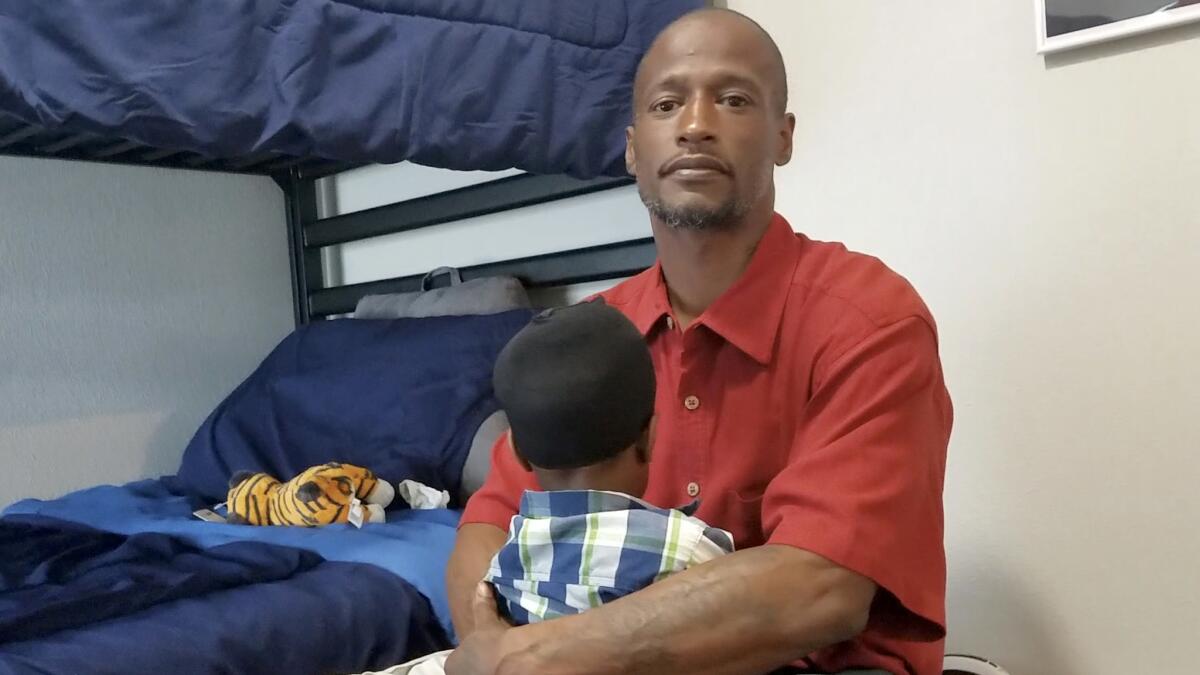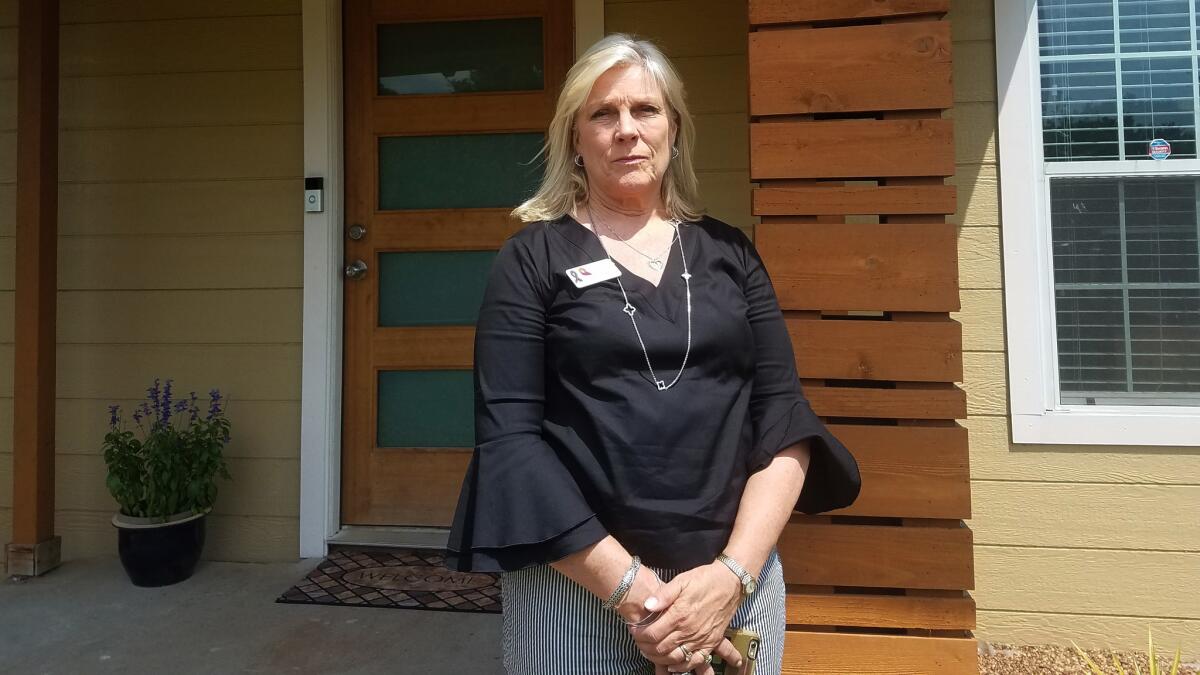‘It’s hard for a guy to say, “I need help.”’ How shelters reach out to male victims of domestic violence

- Share via
Reporting from Dallas — When Joshua Miller’s girlfriend attacked him, smashing their son’s toy guitar against his forehead, he was the one that police officers put in handcuffs.
It was not until a neighbor backed up his story that police removed the cuffs and Miller found himself seeking refuge at one of the nation’s first domestic violence shelters devoted to men.
“Men are not looked at as victims,” said the 36-year-old as he cradled his 2-year-old son, Jordan, next to their bunk at the Family Place shelter in Dallas. “People say, ‘A woman can’t hurt you. Pick your head up off your shoulders. Oh man, that’s nothing.’ But it’s not nothing — especially when kids are seeing this.”
After decades of feminist campaigning about the plight of battered women, a small but growing number of men are seeking help and challenging the idea that only women are victims of domestic violence.
Studies have long shown that men and women are on the receiving end at more or less equal rates, though women are much more likely to be injured and to report it.
Last year, the National Domestic Violence Hotline received 12,046 calls and messages from men who said they were victims in abusive relationships — a fraction of the 119,470 interactions with women but a 73% increase from 2014.
“The biggest challenge these men face is that people don’t believe them,” said Paige Flink, chief executive of the Family Place, which opened its male shelter in May. “We’ve gone through a lot of work to get to where women are believed, but now the pendulum has swung to the point that men are assumed to be the aggressor.”
Since 2013, the federal government has required the shelters it funds to offer services to male as well as female victims of domestic abuse. Some shelters allow men to live alongside female clients, while many put them up in hotels and motels.
Nationwide, only the Dallas shelter and one in Batesville, Ark., have temporary housing exclusively for men.
The feminist movement has long resisted the idea that domestic violence against men is a significant social problem. In 1975, when sociologists at the University of New Hampshire published a study suggesting that women were just as likely as men to assault their partners, the researchers faced widespread criticism — including death threats and bomb scares.
Critics argue that not only are men bigger and stronger than women but that domestic violence takes place in the wider framework of a male-dominated society.
“Women’s abuse of men is not a form of discrimination,” said Evan Stark, a forensic social worker and professor emeritus at Rutgers University, who in 1977 founded one of America’s first domestic violence shelters, the New Haven Project for Battered Women. “There is simply no evidence to suggest that investing significant resources in preventing women’s violence against men would improve men’s lives or our communities.”
While women do abuse men on an individual level, Stark said, the frequency and nature of the abuse is less severe than men’s abuse of women, which often involves a pattern of sexual assault and coercive control that reflects a broader system of social inequality.
Those setting up men’s shelters counter that they are committed to helping all victims of domestic abuse.
“What starts as a slap can go to a punch, can go to a push down the stairs,” Flink said. “At the end of the day, there’s just no place for it, regardless of your gender.”
Fifty years ago there were few emergency domestic violence shelters — for men or women. Violence within the home was deemed a “private matter” until grass-roots feminists took up the issue in the 1970s, setting up women’s consciousness-raising groups, hotlines, shelters and crisis centers across the country.
About 1,000 shelters for battered women were established across the country in the 1970s and 1980s. A few also offered services to men.
“Up until the last 10 years, we were just looked at with distaste,” said Carol Crabson, chief executive of Valley Oasis shelter in the California city of Lancaster, which has offered shelter to male and female victims of domestic violence since 1981. “Serving men, the ‘bad guys,’ was just not seen as an OK thing to do.”
Calls from men were rare in Dallas when the Family Place was founded in 1978.
Over the last few years, the number of male clients has risen — from 10 being housed in 2014 to 32 last year. It is on pace to shelter 50 men this year.
As putting men up in hotels became increasingly expensive, the nonprofit decided it could save money and offer a wider range of services by opening a shelter that catered exclusively to them — a modest two-story home with seven bedrooms, an open-plan kitchen and living room, and a basketball hoop in the parking lot out back.
A few weeks after opening, it was full, with eight men and six children.
One man left his wife of 22 years when she hurled household objects at their disabled daughter. Another packed his bags when his boyfriend choked him. A third fled when his brother, whom he suspected of molesting his 10-year-old daughter, stabbed him in the back.
Male victims of domestic violence say they face a particular stigma: They are taught by society not to express their feelings and ridiculed if they tell anyone a woman is abusing them.

“It’s hard for a guy to say ‘I need help,’” Flink said. “It’s just not a natural instinct for a lot of men.”
Margie Heilbronner, the Family Place’s primary care manager, has worked with men for 12 years and says they’ve been attacked with pots of hot grease, screwdrivers, knives, hammers, curling irons, nails, beer bottles and wooden spoons.
They cite the same reasons that women do, she said, for staying with an abusive partner: love, marriage vows, shame, uncertainty over where to go, fear of not seeing their children.
Some experts note that more men are seeking help now as women move closer to equality with men and achieve more economic and social independence. At the same time, more gay, bisexual and transgender people are also reporting violence as families become less traditional and gender roles are considered more fluid.
“There’s really been an opening up in understanding of what families and relationships look like,” said Emily Douglas, an associate professor of social work at Bridgewater State University in Massachusetts. “If women are perpetrating violence against other women and men are perpetrating violence against other men, then that opens up the door for a conversation about what could be the other potential causes of partner violence.”
Institutions are changing too. The Dallas Police Department introduced new domestic violence guidelines, training patrol officers responding to calls to ask a series of questions aimed at identifying men and women at risk and encouraging them to seek services.
“We’re having more conversations now about how men can feel and show emotion,” Flink said. “They don’t have to be the tough patriarch. I think that’s the beginning of the eking-away at this hard box that we’ve put men in.”
Amid the changes, experts say there is too little research on male victims of assault to know how to best serve them. Even those who welcome men to their shelters are divided on whether such housing should be segregated by sex.
Opponents of housing men and women under one roof argue that bringing a man into women’s shelter could “trigger” women and interrupt recovery, or encourage victims to jump into new relationships.
Those who run integrated shelters, however, say there are benefits to having women and men practice interacting with the opposite sex in a safe environment.
“The real world doesn’t isolate you,” Crabson said. “It’s a beautiful opportunity to introduce victims of domestic violence to members of the opposite sex. They talk and they respect each other, they learn to develop trust. They find out that not all men, or all women, are batterers.”
Jarvie is a special correspondent.
ALSO
‘Pharma Bro’ Martin Shkreli calls securities fraud conviction ‘a witch hunt of epic proportions’
No, this isn’t the first time the majority of students admitted by Harvard University are non-white
Portland educators want to strip ‘Lynch’ from school names. But it refers to a family, not lynching
More to Read
Sign up for Essential California
The most important California stories and recommendations in your inbox every morning.
You may occasionally receive promotional content from the Los Angeles Times.











